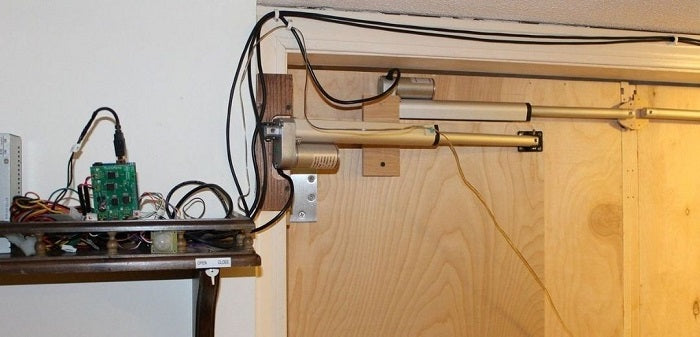We have seen linear actuators used in various fun and exciting applications, with one of the most interesting being their use in escape rooms. Escape rooms have been appearing all over the world, from fixed locations to pop-up rooms. There are over 5000 escape rooms worldwide, which is estimated to increase over the next several years. Each new room iteration is becoming more and more tech-savvy with sensors, lasers, and linear actuators!
This article will combine the logic and automation ideas put forward in past Progressive Automations articles to give you the best use of a linear actuator for an escape room. We have you covered whether you would like to implement a simple keypad or maybe something more advanced like using multiple ultra-sonic sensors.
What Is an Escape Room?
Before we can begin giving you ideas on using a linear actuator for an escape room, let's properly define what an escape room is and why they are so popular. An escape room is a real-time adventure game that takes place in a variety of themed rooms. You would form a team of people and choose an adventure, which could involve a room themed as a prison cell, a pirate ship, a regular house, and many more.

Despite the various room themes, the goal remains the same: get out of the room within 60 minutes or less. How do you do that? By solving puzzles, looking for clues in the room, finding hidden spaces, and many more. Each solved puzzle will get you one step closer to getting out of the room. Escape rooms are a great team-building exercise as you split tasks among your team members to get out of the room in record time.
Escape Room Equipment
Now that we know what an escape room is, how can we use linear actuators in them, and what sort of escape room automation technology would you need? Here are a few pieces of equipment and their use within an escape room.
Keypad Triggers
A keypad mounted next to the escape door can be a great final puzzle to solve to open a hatch, window, or even an automated secret bookcase door to find a hidden item or exit the room entirely.

Enter the correct combination of numbers, which can be determined by solving prior puzzles, and activate a linear actuator.
You would need a linear actuator that is rated according to what your intended application is. For example, if you decide to lift the lid of a box to reveal the next puzzle, the lid's weight would need to be lighter than the linear actuator's full-load rating to avoid it stalling.
You can also trigger other events if the incorrect combination is entered on the keypad, such as closing off areas of the room and signalling an alarm. You can have one combination code to extend the linear actuator and a different code to retract it. The possibilities are endless when using a keypad for escape room automation. For a more detailed guide, visit our article on how to control an actuator with a keypad.
Sensor Triggers (Hall Effect or Ultra-Sonic)
Escape room equipment can include sensors that can control the position of a linear actuator and are by far the best way of making an escape room even more exciting and interactive. Moreover, sensors can be concealed and can be activated with a magnet (reed switch or Hall effect sensor), by proximity to it (ultra-sonic sensor), or by light (light dependent resistor).

An ultra-sonic sensor can determine the distance an object is away from it. A microcontroller can translate this distance into a linear actuator position. The closer you get to the sensor, the further the linear actuator moves. For example, an ultra-sonic sensor can be concealed within the escape room, and when an object is placed in front of it, it will trigger a linear actuator to open a secret door. Alternatively, more than one ultra-sonic sensor can be used in a configuration where teams would have to stand in certain positions in the room to activate the linear actuator. For a more detailed guide, visit our article on how to control your actuator using an ultra-sonic sensor. You can also learn more about using a linear actuator with a microcontroller here!
Since an ultra-sonic sensor is tricky to conceal entirely, you can also use a Hall effect sensor hidden behind a thin wall. When a magnet is placed near it, it will trigger the linear actuator. Additionally, the linear actuator can move incrementally based on the number of times the magnet passes the hall effect sensor until the linear actuator fully extends/retracts to reveal the next puzzle or clue.
Safety Considerations
When installing escape room automation technology, it is vital to consider the safety of the people inside the room. If a powerful linear actuator is opening a secret door, it could potentially hit someone – installing force or current sensors is a way of preventing serious injury. When a person is in the way of a door that is being opened with a linear actuator, the force sensor will exceed the threshold value, and the linear actuator can either be made to stop or retract to its original position.

Furthermore, some linear actuators from Progressive Automations come with a form of overload protection to protect the longevity of the actuator, which includes overcurrent protection, mechanical slip clutches, or built-in electrical shutoffs. Take a look at the PA-06, PA-13, PA-17, and PA-17-POT models for these overprotection options. Progressive Automations also stock various sensor modules that can be used for escape room automation, making integration with an Arduino microcontroller incredibly simple.
Can You Escape in Time?
An escape room is a thrilling experience to share with friends, family, or work colleagues. Escape room automation using linear actuators makes the experience even more enjoyable since players won't know what is coming next or what secrets lurk behind doors. Choose Progressive Automations as your escape room automation supplier and select from our array of quality linear actuators, sensors, and microcontroller boards.
Lastly, be sure to visit our articles page to find out more about automating a linear actuator! If you require some first-hand help outside of our articles, please don’t hesitate in reaching out to us. We love helping customers with their applications, and would love to be involved!




